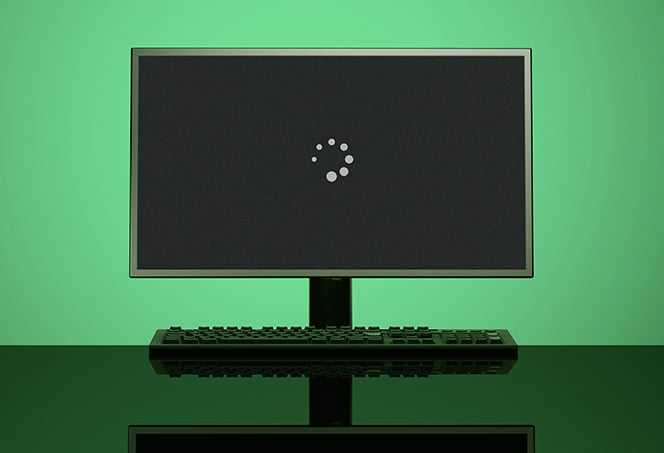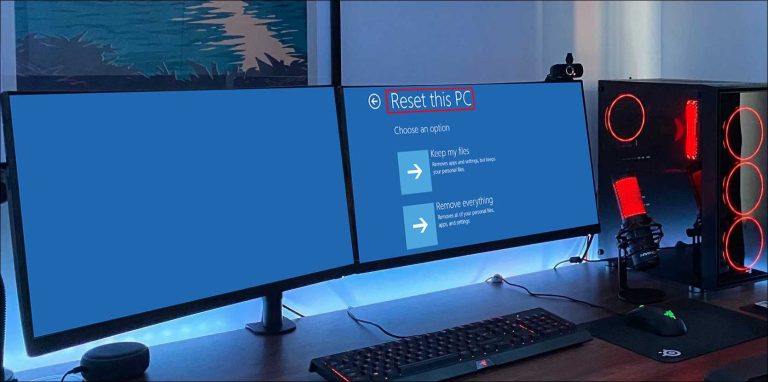If your PC monitor suddenly goes completely blank, don’t panic—this issue is often fixable with a few simple steps. First, check that your cables are securely connected, and restart your computer. If the problem persists, try adjusting the display settings or updating your graphics driver. Sometimes, the issue could be as straightforward as a loose cable or a temporary glitch, but other times it requires deeper troubleshooting. The good news is that most blank screen problems can be resolved without professional help, saving you time and stress. Just stay calm, follow a systematic approach, and you’ll likely have your display up and running again in no time.
To fix a blank screen on your PC monitor, start by checking all physical connections, restarting your device, and testing with a different cable or monitor. If those steps don’t work, update your graphics driver or boot into Safe Mode to identify software conflicts. Most issues are caused by simple hardware or software hiccups that are easily fixable. By methodically troubleshooting, you can quickly identify the root cause and get your screen back to normal.
How to fix a blank screen on your PC monitor
Understanding Why Your Screen Turns Blank
When your monitor display goes blank, it can be caused by various issues. Sometimes, it’s a simple problem like loose cables, and other times, it could be a hardware malfunction. Knowing the root of the problem is the first step to fixing it effectively.
Checking Power Supply and Connections
Start by ensuring the monitor is properly plugged into a power source. Confirm that the power cable is securely connected to both the monitor and the outlet. If the monitor has a power indicator light, check if it is on or blinking, which can give clues about the issue.
Verify Power Button and Power Socket
Make sure the monitor’s power button is pressed and turned on. Test the power outlet by plugging in another device to see if it works. If the outlet is faulty, switch to a different power socket.
Inspecting Video Cables and Ports
Examine the video cables such as HDMI, DisplayPort, VGA, or DVI for damage or loose connections. Tighten the cables and try replacing them if you suspect they are faulty. Also, check that cables are plugged into the correct ports on your computer and monitor.
Troubleshooting Hardware Connections
Loose or damaged cables are a common cause of blank screens. Follow these steps to ensure all hardware connections are secure:
- Disconnect all video cables from your PC and monitor.
- Reconnect the cables firmly, making sure they click into place.
- Use a different cable if you have one available.
- Repeat the process for all display connections.
Testing with Different Devices
To isolate the problem, connect your monitor to a different computer or device. If the screen stays blank on another device, the issue likely lies with the monitor itself. Conversely, if the monitor displays correctly, your first computer may need troubleshooting.
Adjusting Display Settings and Resolution
Incorrect display settings can sometimes cause a blank screen. Restart your computer in safe mode to see if the display appears. Once in safe mode, check your resolution settings and adjust them if necessary.
How to Boot into Safe Mode
Press and hold the Shift key while clicking Restart on your Windows login screen. Choose Troubleshoot, then Advanced options, and select Startup Settings. Click Restart, then press 4 to enable Safe Mode.
Modifying Screen Resolution
Right-click on your desktop and select Display Settings. Choose a lower resolution and refresh rate, then apply the changes. Restart your computer normally to see if the issue resolves.
Updating or Reinstalling Graphics Drivers
Outdated or corrupted graphics drivers can cause display problems. Visit your GPU manufacturer’s website to download the latest driver version. Alternatively, use your operating system’s device manager to update or uninstall drivers.
- Open Device Manager.
- Find Display Adapters and expand the list.
- Right-click your graphics card and select Update Driver.
- Follow on-screen instructions or choose to browse your computer for driver updates.
Reinstalling Drivers
If updating doesn’t help, uninstall the driver and restart your PC. Windows will automatically reinstall the default driver, which you can then replace with the latest version.
Performing Hardware Tests and Diagnoses
Use built-in tools or third-party utilities to diagnose hardware health. Many monitors have self-test features, which can help identify if the monitor itself is faulty.
Test the Monitor with Built-in Diagnostic Tools
Check your monitor’s manual for specific self-test procedures. Usually, this involves disconnecting the video input and turning on the monitor, which then displays diagnostic patterns if functioning properly.
Running Hardware Diagnostics on Your PC
Use tools like Windows Memory Diagnostic or hardware-specific utilities to check your RAM, GPU, and other components. Faulty hardware can result in display issues including blank screens.
Resetting and Repairing Your Monitor
Reset your monitor settings to default. Many monitors have an on-screen menu where you can access the reset option. If resetting doesn’t work, consider professional repair or replacement.
Performing a Factory Reset
Access the monitor’s menu via buttons on the side or bottom. Navigate to Settings or Setup, then select Reset or Factory Reset. This can clear any misconfigured display settings causing the blank screen.
Checking for Physical Damage
Inspect the monitor for signs of physical damage such as cracks, dead pixels, or flickering. Physical damage may require professional repair or a new monitor.
Addressing Software and System Issues
Software conflicts or operating system glitches can cause display failures. Keep your system updated to avoid compatibility problems.
Updating Windows or Your Operating System
Go to Settings > Update & Security > Windows Update, then click Check for updates. Install any available updates to fix bugs that might affect display functionality.
Performing a System Restore
If the blank screen started after software changes, perform a system restore to revert to a previous state. Search for ‘System Restore’ in Windows and follow the prompts.
Considering External Factors and Environmental Conditions
Environmental issues can impact monitor performance. Ensure your workspace is free from electrical interference, extreme temperatures, and moisture.
Check for Electromagnetic Interference
Keep your monitor away from devices like speakers, routers, or magnets that can interfere with the display.
Ensure Proper Ventilation and Operating Environment
Avoid placing the monitor in direct sunlight or humid areas. Maintain a consistent temperature to prevent hardware overheating.
When to Seek Professional Help
If after these steps the screen remains blank, the problem might be hardware failure. Consult a professional technician to diagnose potential issues with your monitor or graphics card.
Summary of Key Steps
| Step | Action |
|---|---|
| Power Check | Ensure monitor and outlet are working |
| Connection Inspection | Secure and replace video cables as needed |
| Hardware Testing | Test with different devices or cables |
| Display Settings | Adjust resolution and boot into safe mode |
| Driver Update | Use Device Manager or manufacturer’s website |
| Physical Inspection | Check for damage or perform self-test |
| Software Troubleshooting | Update OS, reset system, or restore |
| Environmental Check | Remove interference sources and ensure proper environment |
Regular maintenance and cautious handling can prevent many display issues. Following these detailed troubleshooting steps will help you identify whether the problem is minor or requires professional repair. Keep your system updated and handle hardware carefully to ensure your monitor stays in good working condition.
Do this to fix blank screen issue on windows
Frequently Asked Questions
What steps can I take if my monitor shows no image when I turn on my PC?
If your monitor displays no image, start by checking all cable connections between your monitor and computer. Ensure the video cable is securely connected and not damaged. Test the monitor with another device to confirm it works properly. Also, verify that your computer is powered on and that the graphics card is properly seated if you installed a separate card. If these steps don’t resolve the issue, try restarting your PC and see if the display appears during the boot process.
How do I troubleshoot if my monitor displays a black screen after login?
If the screen turns black after you log in, first check the display settings on your computer. Sometimes, the resolution or refresh rate may be incompatible with your monitor. Boot into safe mode to adjust display settings to default. Also, update your graphics drivers to ensure compatibility. Disconnect any external devices that might interfere with the display. If the problem persists, test the monitor with a different cable or connect it to another computer to identify if the issue lies with the monitor itself.
What can I do if my monitor shows a flickering or flashing blank screen?
Flickering or flashing screens often relate to refresh rate issues or loose connections. Adjust the refresh rate within your display settings to a rate supported by your monitor. Check and tighten all video cables to prevent intermittent connections. Update your graphics driver to fix potential software glitches. Additionally, test the monitor with another cable or on a different port to determine if the problem is hardware-related. If the flickering continues, consider trying a different monitor to identify the source of the issue.
Final Thoughts
Pour conclure, how to fix a blank screen on your PC monitor involves simple steps. Check all cable connections and replace any damaged cables. Restart your computer and ensure the monitor is set to the correct input source. If the problem persists, update your graphics drivers or test the monitor with another device. Following these tips will help you troubleshoot effectively and resolve the issue quickly.
I’m passionate about hardware, especially laptops, monitors, and home office gear. I share reviews and practical advice to help readers choose the right devices and get the best performance.






